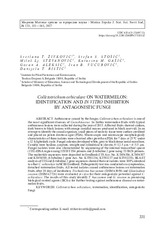Приказ основних података о документу
Colletotrichum orbiculare on watermelon - identification and in vitro inhibition by antagonistic fungi
| dc.creator | Zivkovic, Svetlana | |
| dc.creator | Stošić, Stefan | |
| dc.creator | Stevanović, Miloš | |
| dc.creator | Gašić, Katarina | |
| dc.creator | Aleksic, Goran | |
| dc.creator | Vučurović, Ivan | |
| dc.creator | Ristić, Danijela | |
| dc.date.accessioned | 2023-09-24T21:35:00Z | |
| dc.date.available | 2023-09-24T21:35:00Z | |
| dc.date.issued | 2017 | |
| dc.identifier.issn | 0352-4906 | |
| dc.identifier.issn | 2406-0828 | |
| dc.identifier.uri | https://plantarum.izbis.bg.ac.rs/handle/123456789/1013 | |
| dc.description.abstract | Anthracnose caused by the fungus Colletotrichum orbiculare is one of the most significant diseases of Cucurbitaceae. In Serbia watermelon fruits with typical anthracnose lesions were collected during the year of 2015. Affected fruits showed sunken, dark brown to black lesions with orange conidial masses produced in black acervuli. In an attempt to identify the causal organism, small pieces of necrotic tissue were surface sterilized and placed on potato dextrose agar (PDA). Macroscopic and microscopic morphologicaly characteristics of three isolates were observed after growth on PDA for 7 days at 25 ºC under a 12 h light/dark cycle. Fungal colonies developed white, grey to black dense aerial mycelium. Conidia were hyaline, aseptate, straight and cylindrical to clavate, 9–12.5 μm × 4–5.5 μm. Fungal isolates were also characterized by sequencing of the internal transcribed spacer (ITS) rDNA region using ITS1F/ITS4 primers and β-tubuline 2 gene using T1/Bt2b primers. The nucleotide sequences were deposited in GenBank (ITS Acc. No. KT454386, KT454387 and KT454388; β-tubuline 2 gene Acc. No. KT581236, KT581237 and KT581238). BLAST analysis of ITS and β-tubuline 2 gene sequences showed that our isolates were 100% identical to other C. orbiculare in NCBI GenBank. Pathogenicity test was conducted on symptomless, detached watermelon fruits. All tested isolates caused anthracnose lesions on watermelon fruits after 10 days of incubation. Trichoderma harzianum (DSM 63059) and Gliocladium roseum (DSM 62726) were evaluated in vitro for their antagonistic potential against C. orbiculare. The results of this study identify T. harzianum and G. roseum as promising biological control agents (BCAs) for further testing against anthracnose disease on watermelon fruits. | sr |
| dc.language.iso | en | sr |
| dc.publisher | Herbološko društvo Srbije | sr |
| dc.relation | info:eu-repo/grantAgreement/MESTD/Technological Development (TD or TR)/31018/RS// | sr |
| dc.relation | info:eu-repo/grantAgreement/MESTD/Basic Research (BR or ON)/173026/RS// | sr |
| dc.rights | openAccess | sr |
| dc.rights.uri | https://creativecommons.org/licenses/by-nc-nd/4.0/ | |
| dc.source | Zbornik Matice srpske za prirodne nauke | sr |
| dc.subject | Colletotrichum orbiculare | sr |
| dc.subject | watermelon | sr |
| dc.subject | identification | sr |
| dc.subject | antagonistic fungi | sr |
| dc.title | Colletotrichum orbiculare on watermelon - identification and in vitro inhibition by antagonistic fungi | sr |
| dc.type | article | sr |
| dc.rights.license | BY-NC-ND | sr |
| dc.citation.epage | 343 | |
| dc.citation.spage | 331 | |
| dc.citation.volume | 133 | |
| dc.type.version | publishedVersion | sr |
| dc.identifier.doi | 10.2298/ZMSPN1733331Z | |
| dc.identifier.fulltext | http://plantarum.izbis.bg.ac.rs/bitstream/id/3345/bitstream_3345.pdf |


